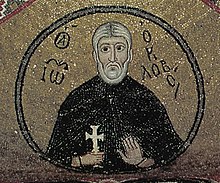John the Dwarf
 From Wikipedia the free encyclopedia
From Wikipedia the free encyclopedia
Saint John the Dwarf | |
|---|---|
 Mosaic in Hosios Loukas | |
| Born | c. 339 Thebes, Egypt[1] |
| Died | c. 405 Mount Colzim, Egypt |
| Venerated in | Roman Catholic Church Eastern Orthodox Church Oriental Orthodox Churches |
| Feast | Paopi 20 (Coptic Christianity) (i.e. October 17 Julian Calendar) October 17 (Roman Catholic) November 9 (Eastern Orthodox Church) |
| Attributes | Short Monk watering a stick |
John the Dwarf (Greek: Ἰωάννης Κολοβός; Arabic: ابو يحنّس القصير (Abū) Yuḥannis al-Qaṣīr c. 339 – c. 405), also called John Colobus, John Kolobos or Abba John the Dwarf,[2] was a Coptic Desert Father of the early Christian church.
Life[edit]
John the Dwarf was born in the town of Thebes in Egypt to poor Christian parents. At the age of eighteen, he and an elder brother, moved to the desert of Scetes[3] where he became a disciple of Pambo and a good friend of Pishoy. He lived a life of austerity and taught several other monks his way of life, among them was Arsenius the Great.[4]
After the departure of Pambo, John was ordained a priest by Pope Theophilus and became abbot of the monastery he founded around the Tree of Obedience. When the Mazices invaded Scetes in 395, John fled the Nitrian Desert and went to live on Mount Colzim, near the present city of Suez, where he died.
In 515, the relics of John the Dwarf were moved to the Nitrian Desert. His feast is celebrated on October 17 in the Roman Catholic Church, on 20 Paopi at the Coptic Orthodox Church and on November 9 in the Eastern Orthodox Church. The Monastery of Saint John the Dwarf in Scetes is now recognized by the Coptic orthodox church.
John lived on only flatbread and vegetables his entire life and could eat one meal a day.[5]
Legend[edit]
John the Dwarf is best known for his obedience. The most famous story about his obedience is that one day Pambo gave John a piece of dry wood and ordered him to plant and water it. John obeyed and went on watering it twice a day even though the water was about 12 miles from where they lived. After three years, the piece of wood sprouted and grew into a fruitful tree. Pambo took some of this tree's fruits and went around to all the elder monks, saying "take, eat from the fruit of obedience". Postumian, who was in Egypt in 402, assured that he was shown this tree which grew in the yard of the monastery and which he saw covered with shoots and green leaves.[6]
Ababius, a monk of Scetes and a saint of the Coptic Church, is the subject of a long biography attributed in manuscript form to John the Dwarf. The manuscript has yet to be translated into English.
References[edit]
- ^ "القديس يوأنس القصير | الأنبا يحنس القصير | أنبا يوحنا القصير | St-Takla.org". st-takla.org.
- ^ Ward, Benedicta (1975). The Sayings of the Desert Fathers: The Alphabetical Collection. Cistercian Publications. ISBN 978-0879079598.
- ^ "Saint John the Dwarf, Anchoret of Scete. September 15. Rev. Alban Butler. 1866. Volume IX: September. The Lives of the Saints". www.bartleby.com. 12 January 2023.
- ^ "Venerable Arsenius the Great", OCA
- ^ Stefaniw, Blossom. (2019). Christian Reading: Language, Ethics, and the Order of Things. University of California Press. p. 11. ISBN 978-0520300613
- ^ "Saint John The Short ", CopticChurch.net
Sources[edit]
- Saint John the Dwarf
- Orthodox Church of America, Feasts and Saints
- Atiya, Aziz S. The Coptic Encyclopedia. New York: Macmillan Publishing Co., 1991. ISBN 0-02-897025-X
Further reading[edit]
- "The Arabic Life of St. John the Little by Zacharias of Sakha". Coptica. Translated by Davis, Stephen J. Los Angeles, CA, US: St. Shenouda the Archimandrite Coptic Society: 1–185. 2008. ISSN 1541-163X. OCLC 50412347.
- Zacharias of Sakha; Mikhail, Maged S. A.; Vivian, Tim; Greer, Rowan A. (2010). The Holy Workshop of Virtue: The Life of John the Little. Collegeville, MN, US: Liturgical Press. ISBN 978-0-87907-935-2. OCLC 939864685.
